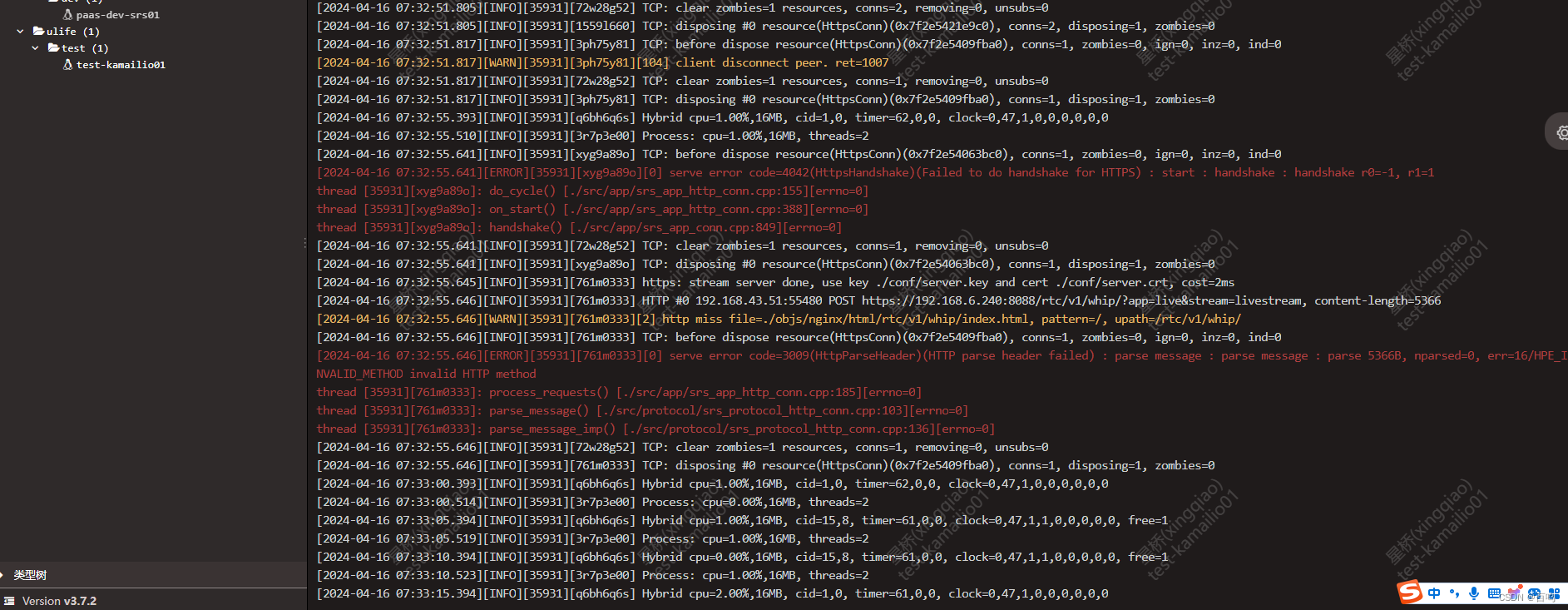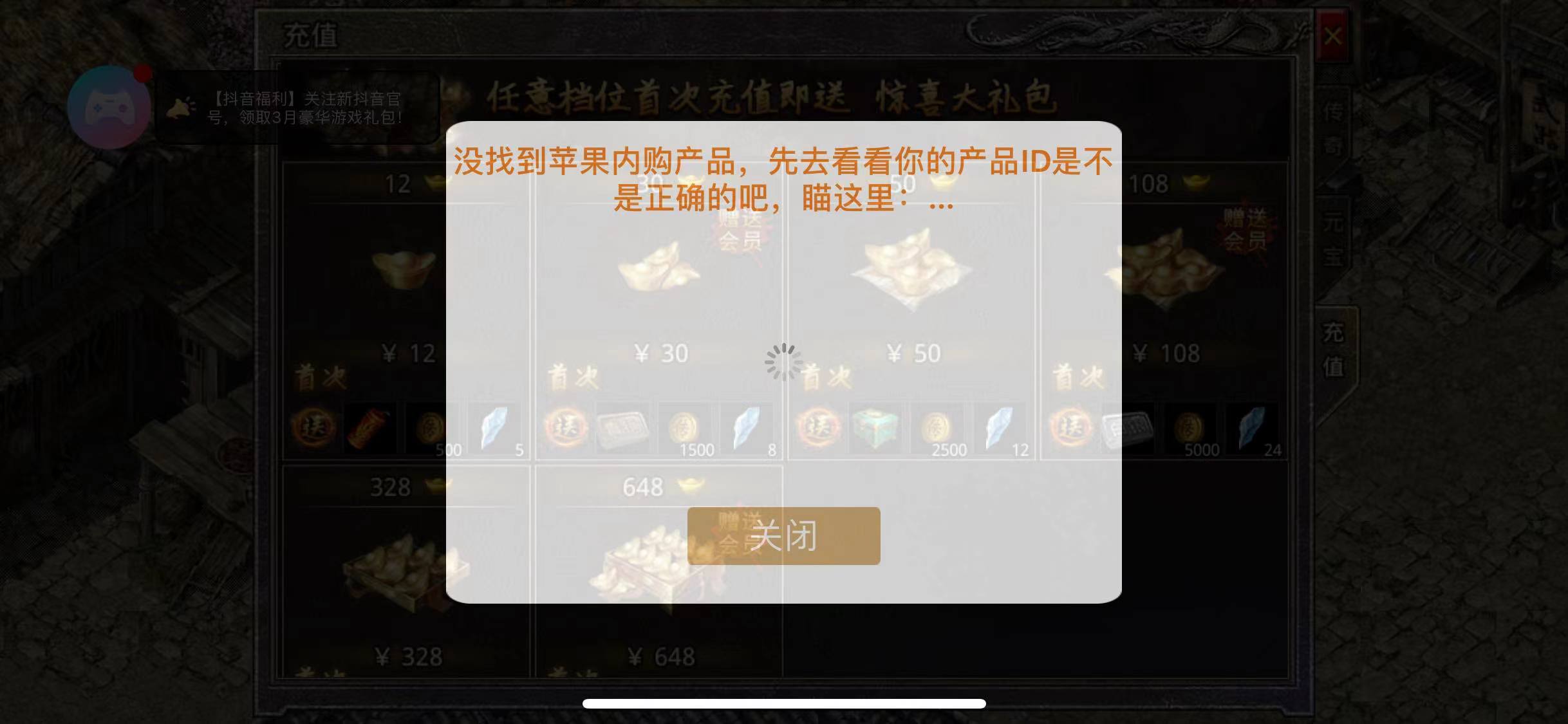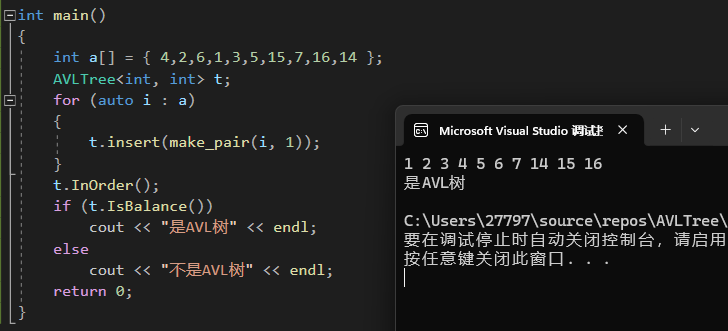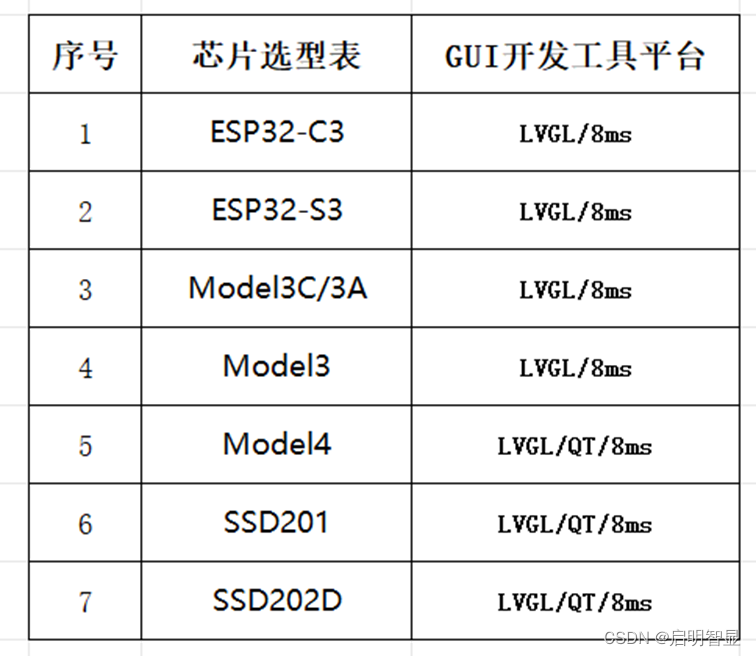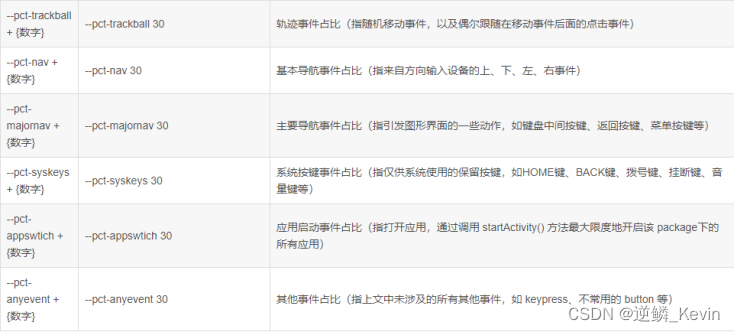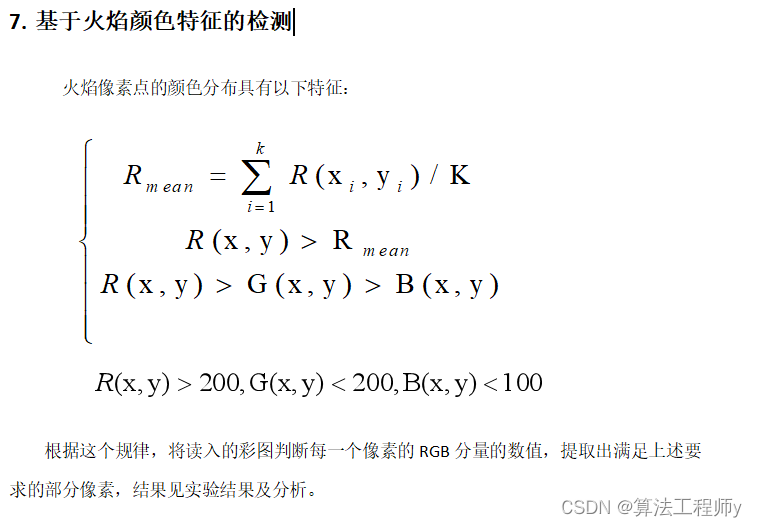troop主页
临近五一放假,祝大家节日快乐,我们的学习还在路上!!
在前面一章我们已经实现出了红黑树的基本框架,现在我们要有这个底层结构去封装map和set。
一 红黑树的迭代器
但在这之前我们要先把红黑树的迭代器实现出来,因为map和set也是有迭代器的。
迭代器常用的有这么几个"-> * ++ == !="这个几个中++的实现是重点,其他的较为简单。
1.2 operator++
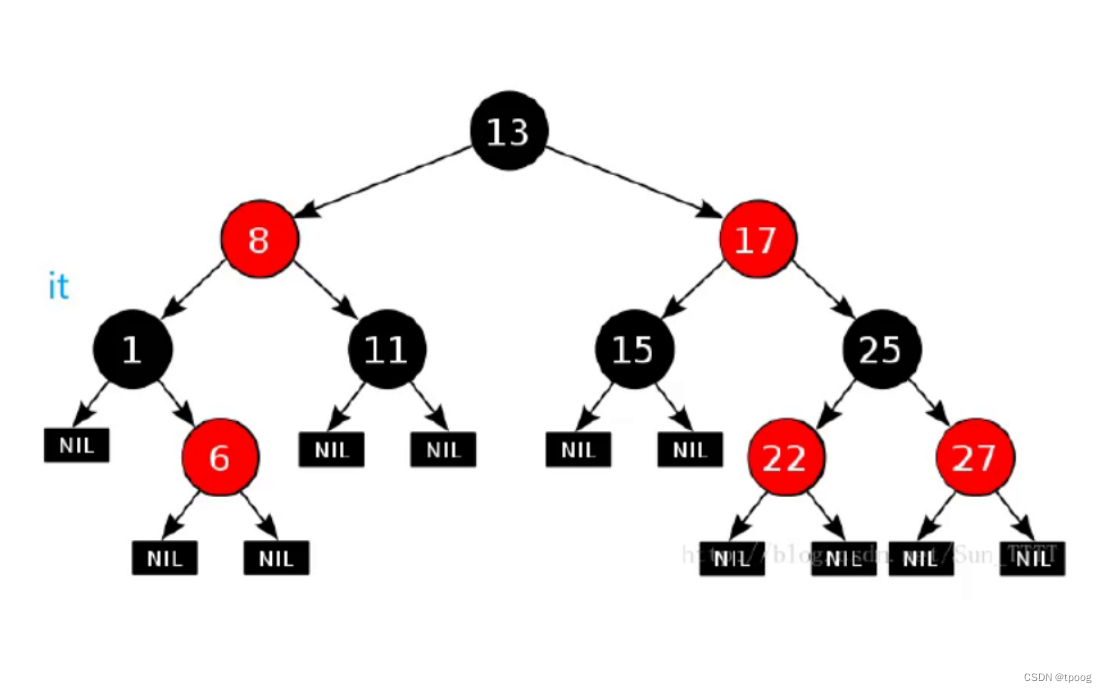
要理解++首先我们要知道++后下一个节点是谁。当然红黑树走的是中序遍历,
举两个例子,假如it现在是在13的位置上,那么++it下一个点是谁?
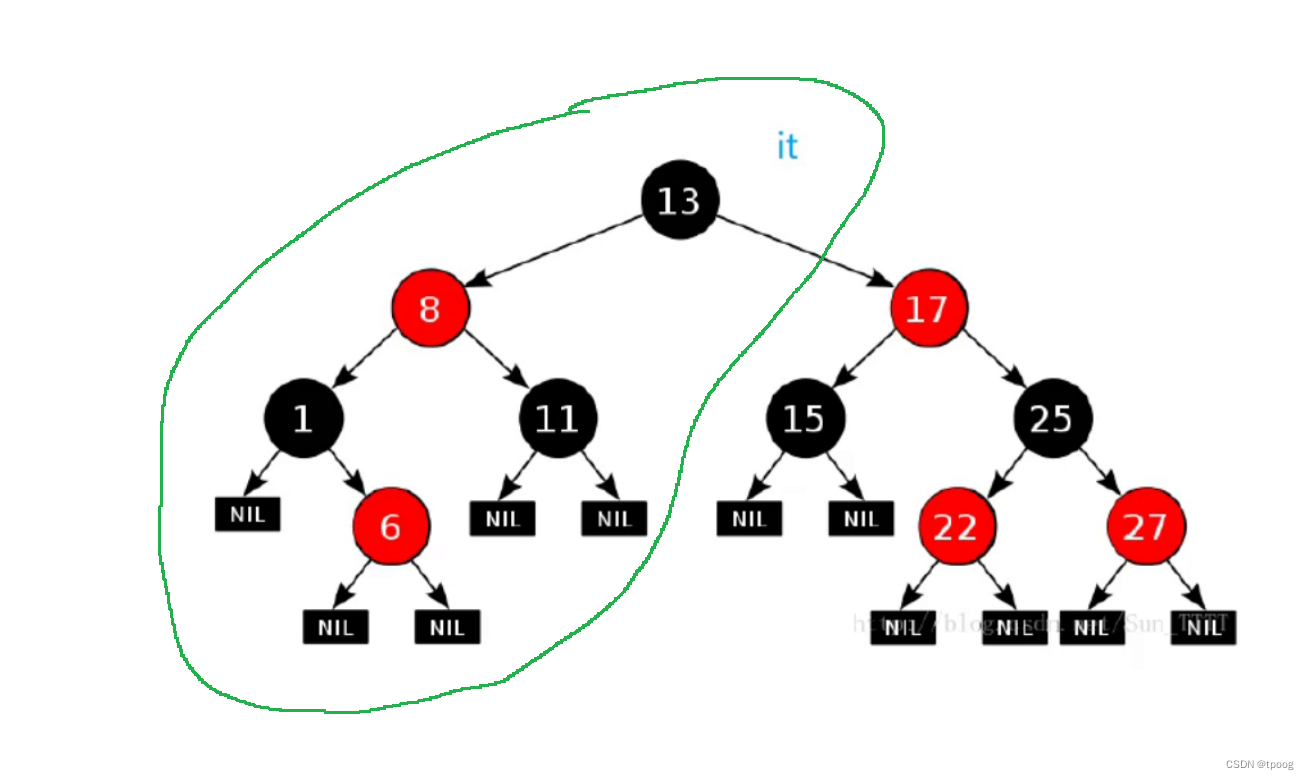
中序:左子树+根+右子树。所以当it在13的位置时说明他的左子树已经全部遍历完成了,现在就要到右子树的最左节点也就是15.
那如果it现在在15的位置时,++it呢?可以看见,15的右子树为空,那就要寻找他的父亲节点也就是17.
分析完毕,我们来总结一下。
- 当it指向的当前节点的右子树不为空,那就去寻找此节点右子树的最左节点。
- 当it指向的当前节点的右子树为空,说明这个节点的中序遍历已经结束了,要向上返回了,下一个节点就是孩子=父亲的左,这个节点。
这里还有一些细节问题。当我们在向上返回的时候,如果cur走到了根节点,那么parent这个节点就会出现越界访问的问题,所以在写条件的时候要加上这一点。
Self& operator++()
{
if (_node->_right && _node)//右子树不为空
{
Node* subLeft = _node->_left;
while (subLeft->_left)
{
subLeft = subLeft->_left;
}
_node = subLeft;
}
else//右子树为空
{
Node* cur = _node;
Node* parent = cur->_parent;
while (cur == parent->_right && parent)
{
cur = parent;
parent = cur->_parent;
}
_node = parent;
}
return *this;
}
1.3 迭代器完整代码
template<class T>
struct RBTreeIterator
{
typedef RBTreeNode<T> Node;
typedef RBTreeIterator<T> Self;
Node* _node;
T* operator->()
{
return &_node->_data;
}
T& operator*()
{
return _node->_data;
}
Self& operator++()
{
if (_node->_right && _node)//右子树不为空
{
Node* subLeft = _node->_left;
while (subLeft->_left)
{
subLeft = subLeft->_left;
}
_node = subLeft;
}
else//右子树为空
{
Node* cur = _node;
Node* parent = cur->_parent;
while (cur == parent->_right && parent)
{
cur = parent;
parent = cur->_parent;
}
_node = parent;
}
return *this;
}
bool operator!=(const Self& s)
{
return _node != s._node;
}
bool operator == (const Self & s)
{
return _node == s._node;
}
};
二 封装
这一部分刚开始看可能会有些晕,因为我们要在三个文件中来回的更改代码。
2.1改造红黑树
因为关联式容器中存储的是<key,value>的键对值,因此我们不能单纯的写K和V。
这里的value对于map和set来说是完全不一样的。
对于set来说value就是K
对于map来说value就是pair<K,V>
那么对于模板来说set就是<K,K>
对于map就是<K,pair<K,V>>
//template<class K, class V>
template<class T>
struct RBTreeNode
{
RBTreeNode<T>* _left;
RBTreeNode<T>* _right;
RBTreeNode<T>* _parent;
//pair<K, V> _kv;
T _data;
Colour _col;
RBTreeNode(const T data)
:_left(nullptr)
, _right(nullptr)
, _parent(nullptr)
, _data(data)
, _col(RED)
{}
};
这里改造前的代码我搞成了注释,方便大家观察。下面有K,V的也都改成了T。
现在我们把map和set写出来,再梳理一遍
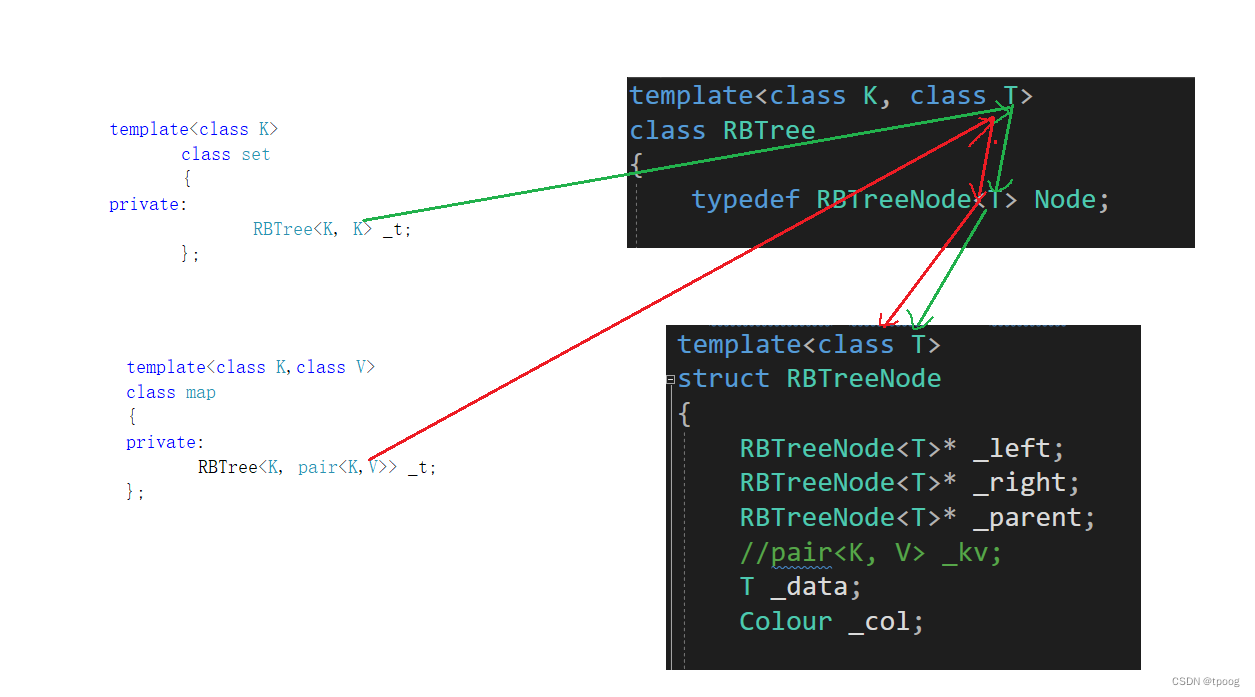
但此时又产生了一个新的问题,我们的比较大小怎么办?我们预期的比较大小是只有first比较也就是K比较,而seco是不参与比较的。我们先来看一看库里面的pair有没有比较。

库里面的pair还有second的比较这是不符合我们的预期的,那么我们要怎么做呢?
我们可以自己写一个仿函数来进行比较。写一个仿函数
1.如果是set就取出key
struct setKeyOfT
{
const K& operator()(const K& key)
{
return key;
}
};
2.如果是map取出pair里面的key
struct mapKeyOfT
{
const K& operator()(const pair<K, V>& kv)
{
return kv.first;
}
};
我们在红黑树的类型中加入这个仿函数,并且在每个需要用到key的位置上加入这个仿函数。
三 代码全
1 RBTree
#pragma once
#include<vector>
#include<iostream>
using namespace std;
enum Colour
{
RED,
BLACK
};
//template<class K, class V>
template<class T>
struct RBTreeNode
{
RBTreeNode<T>* _left;
RBTreeNode<T>* _right;
RBTreeNode<T>* _parent;
//pair<K, V> _kv;
T _data;
Colour _col;
RBTreeNode(const T data)
:_left(nullptr)
, _right(nullptr)
, _parent(nullptr)
, _data(data)
, _col(RED)
{}
};
template<class T>
struct RBTreeIterator
{
typedef RBTreeNode<T> Node;
typedef RBTreeIterator<T> Self;
Node* _node;
T* operator->()
{
return &_node->_data;
}
T& operator*()
{
return _node->_data;
}
Self& operator++()
{
if (_node->_right && _node)//右子树不为空
{
Node* subLeft = _node->_left;
while (subLeft->_left)
{
subLeft = subLeft->_left;
}
_node = subLeft;
}
else//右子树为空
{
Node* cur = _node;
Node* parent = cur->_parent;
while (cur == parent->_right && parent)
{
cur = parent;
parent = cur->_parent;
}
_node = parent;
}
return *this;
}
bool operator!=(const Self& s)
{
return _node != s._node;
}
bool operator == (const Self & s)
{
return _node == s._node;
}
};
template<class K, class T, class KeyOfT>
class RBTree
{
typedef RBTreeNode<T> Node;
public:
typedef RBTreeIterator<T> iterator;
iterator begin()
{
Node* subLeft = _root;
while (subLeft && subLeft->_left)
{
subLeft = subLeft->_left;
}
return iterator(subLeft);
}
iterator end()
{
return iterator(nullptr);
}
bool Insert(const T& data)
{
if (_root == nullptr)
{
_root = new Node(data);
_root->_col = BLACK;
return true;
}
KeyOfT kot;
Node* parent = nullptr;
Node* cur = _root;
while (cur)
{
if (kot(cur->_data) < kot(data))
{
parent = cur;
cur = cur->_right;
}
else if (kot(cur->_data) > kot(data))
{
parent = cur;
cur = cur->_left;
}
else
{
return false;
}
}
cur = new Node(data); // 红色的
if (kot(parent->_data) < kot(data))
{
parent->_right = cur;
}
else
{
parent->_left = cur;
}
cur->_parent = parent;
while (parent && parent->_col == RED)
{
Node* grandfather = parent->_parent;
if (parent == grandfather->_left)
{
Node* uncle = grandfather->_right;
// 情况一:叔叔存在且为红
if (uncle && uncle->_col == RED)
{
// 变色
parent->_col = uncle->_col = BLACK;
grandfather->_col = RED;
// 继续往上处理
cur = grandfather;
parent = cur->_parent;
}
else
{
// 情况二:叔叔不存在或者存在且为黑
// 旋转+变色
if (cur == parent->_left)
{
// g
// p u
// c
RotateR(grandfather);
parent->_col = BLACK;
grandfather->_col = RED;
}
else
{
// g
// p u
// c
RotateL(parent);
RotateR(grandfather);
cur->_col = BLACK;
grandfather->_col = RED;
}
break;
}
}
else
{
Node* uncle = grandfather->_left;
// 情况一:叔叔存在且为红
if (uncle && uncle->_col == RED)
{
// 变色
parent->_col = uncle->_col = BLACK;
grandfather->_col = RED;
// 继续往上处理
cur = grandfather;
parent = cur->_parent;
}
else
{
// 情况二:叔叔不存在或者存在且为黑
// 旋转+变色
// g
// u p
// c
if (cur == parent->_right)
{
RotateL(grandfather);
parent->_col = BLACK;
grandfather->_col = RED;
}
else
{
// g
// u p
// c
RotateR(parent);
RotateL(grandfather);
cur->_col = BLACK;
grandfather->_col = RED;
}
break;
}
}
}
_root->_col = BLACK;
return true;
}
void RotateL(Node* parent)
{
Node* subR = parent->_right;
Node* subRL = subR->_left;
parent->_right = subRL;
if (subRL)
subRL->_parent = parent;
subR->_left = parent;
Node* ppnode = parent->_parent;
parent->_parent = subR;
if (parent == _root)
{
_root = subR;
subR->_parent = nullptr;
}
else
{
if (ppnode->_left == parent)
{
ppnode->_left = subR;
}
else
{
ppnode->_right = subR;
}
subR->_parent = ppnode;
}
}
void RotateR(Node* parent)
{
Node* subL = parent->_left;
Node* subLR = subL->_right;
parent->_left = subLR;
if (subLR)
subLR->_parent = parent;
subL->_right = parent;
Node* ppnode = parent->_parent;
parent->_parent = subL;
if (parent == _root)
{
_root = subL;
subL->_parent = nullptr;
}
else
{
if (ppnode->_left == parent)
{
ppnode->_left = subL;
}
else
{
ppnode->_right = subL;
}
subL->_parent = ppnode;
}
}
void _InOrder(Node* root)
{
if (root == nullptr)
return;
_InOrder(root->_left);
cout << root->_kv.first << endl;
_InOrder(root->_right);
}
void InOrder()
{
_InOrder(_root);
}
bool Check(Node* cur, int blackNum, int refBlackNum)
{
if (cur == nullptr)
{
if (refBlackNum != blackNum)
{
cout << "黑色节点的数量不相等" << endl;
return false;
}
//cout << blackNum << endl;
return true;
}
if (cur->_col == RED && cur->_parent->_col == RED)
{
cout << cur->_kv.first << "存在连续的红色节点" << endl;
return false;
}
if (cur->_col == BLACK)
++blackNum;
return Check(cur->_left, blackNum, refBlackNum)
&& Check(cur->_right, blackNum, refBlackNum);
}
bool IsBalance()
{
if (_root && _root->_col == RED)
return false;
int refBlackNum = 0;
Node* cur = _root;
while (cur)
{
if (cur->_col == BLACK)
refBlackNum++;
cur = cur->_left;
}
return Check(_root, 0, refBlackNum);
}
size_t Size()
{
return _Size(_root);
}
size_t _Size(Node* root)
{
if (root == NULL)
return 0;
return _Size(root->_left)
+ _Size(root->_right) + 1;
}
Node* Find(const K& key)
{
Node* cur = _root;
while (cur)
{
if (cur->_kv.first < key)
{
cur = cur->_right;
}
else if (cur->_kv.first > key)
{
cur = cur->_left;
}
else
{
return cur;
}
}
return NULL;
}
//int _Height(Node* root)
//{
// if (root == nullptr)
// return 0;
// int leftHeight = _Height(root->_left);
// int rightHeight = _Height(root->_right);
// return leftHeight > rightHeight ? leftHeight + 1 : rightHeight + 1;
//}
//int Height()
//{
// return _Height(_root);
//}
//int GetRotateSize()
//{
// return rotateSize;
//}
private:
Node* _root;
//int rotateSize = 0;
};
//void TestRBTree1()
//{
// //int a[] = { 16, 3, 7, 11, 9, 26, 18, 14, 15 };
// int a[] = { 4, 2, 6, 1, 3, 5, 15, 7, 16, 14,16, 3, 7, 11, 9, 26, 18, 14, 15 };
// RBTree<int, int> t;
// for (auto e : a)
// {
// t.Insert(make_pair(e, e));
//
// // 1、先看是插入谁导致出现的问题
// // 2、打条件断点,画出插入前的树
// // 3、单步跟踪,对比图一一分析细节原因
// //cout << e << "->" << t.IsBalance() << endl;
// }
//
// t.InOrder();
// cout << t.IsBalance() << endl;
//}
2 map
#pragma once
#include"RBTree.h"
namespace yjt
{
template<class K, class V>
class map
{
struct mapKeyOfT
{
const K& operator()(const pair<K, V>& kv)
{
return kv.first;
}
};
public:
typedef typename RBTree<K, pair<K, V>, mapKeyOfT>::iterator iterator;
iterator begin()
{
return _t.begin();
}
iterator end()
{
return _t.end();
}
bool insert(const pair<K,V>& kv)
{
return _t.Insert(kv);
}
private:
RBTree<K, pair<K, V>, mapKeyOfT> _t;
};
void test_map1()
{
map<int,int> m;
int a[] = { 4, 2, 6, 1, 3, 5, 15, 7, 16, 14 };
for (auto e : a)
{
m.insert(make_pair(e, e));
}
map<int,int>::iterator it = m.begin();
while (it != m.end())
{
//if(*it % 2 == 0)
// *it += 100;
cout << it->first << ":" << it->second << endl;
++it;
}
cout << endl;
}
}
3 set
#pragma once
#include"RBTree.h"
namespace yjt
{
template<class K>
class set
{
struct setKeyOfT
{
const K& operator()(const K& key)
{
return key;
}
};
public:
typedef typename RBTree<K,K, setKeyOfT>::iterator iterator;
iterator begin()
{
return _t.begin();
}
iterator end()
{
return _t.end();
}
bool insert(const K& key)
{
return _t.Insert(key);
}
private:
RBTree<K, K, setKeyOfT> _t;
};
void test_set1()
{
set<int> s;
int a[] = { 4, 2, 6, 1, 3, 5, 15, 7, 16, 14 };
for (auto e : a)
{
s.insert(e);
}
set<int>::iterator it = s.begin();
while (it != s.end())
{
//if(*it % 2 == 0)
// *it += 100;
cout << *it << " ";
++it;
}
cout << endl;
}
}
四 总结
这个就需要多写代码去理解,因为代码都普遍比价大一些。
